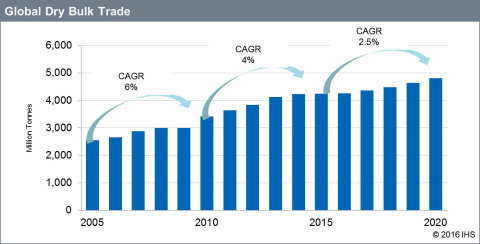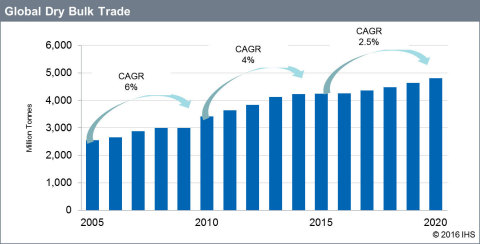SINGAPORE--(BUSINESS WIRE)--Shipping rates for vessels transporting commodities such as coal, iron ore and grains racked up impressive gains in the first quarter of 2016 after hitting record lows, but the rally could flatten out into the second half as the macroeconomic outlook remains uncertain, the latest forecasts show from IHS Inc. (NYSE: IHS), the leading global source of critical information and insight.
Freight rates for large Capesize vessels carrying iron ore along Australia-Far East routes reached $2.99 per tonne in Q1, 2016 and are expected to hover at $3.30 per tonne for the rest of Q2, 2016 after an increase of over 11 percent quarter-on-quarter, while average rates for the Transatlantic Brazil-Far East routes reached $5.8 per tonne in Q1, 2016 and will continue its current upward trend averaging at $8.5 in Q2, 2016 as higher earnings are expected in April and going into May and June.
Panamax vessels along the Australia-India route for coal deliveries, where average spot rates hit $6,100 per day in Q1, 2016, are expected to rise to a forecasted $8,000 in Q2 2016, an approximate 30 percent increase. In contrast, however, Panamax routes loading coal from Indonesia will see a 5 percent decrease in Q2, 2016 as compared to the first quarter, counterbalancing the overall average earnings for an increase of 15 percent or $6,900 per day in Q2, 2016.
The latest forecasts from the new IHS Dry Bulk Freight Rate Forecast service launched today factors in key variables and fundamental drivers that affect future freight rates, such as ship availability, ship utilization, macroeconomic developments, oil market fundamentals, trade data, bond yields, short- and long-term interest rates, exchange rates and commodity prices and production.
“Short-lived rebounds will bring occasional relief to the market,” said Luciana Salles, principal trade analyst at IHS Maritime & Trade. “Many questions remain, however, as to when the current situation in the dry bulk markets will give rise to more sustainable rates on the whole, and whether the overall macroeconomic situation and the fundamental drivers can engender enough confidence to see a price recovery for a more prolonged period of time.”
After being subdued since 2014, the dry bulk market will face a transitional year in 2017, IHS predicts, as demand will finally outpace supply on the back of calmer financial markets that could reinforce a more stable outlook for global growth. At present, US economic growth is expected to accelerate a little moving through 2016, led by consumer spending and homebuilding, while growth in the Eurozone will improve slightly aided by further monetary stimulus.
For 2016, IHS estimates world GDP growth to reach 2.6 percent with real export growth of 2.8 percent. Then in 2017, IHS forecasts 3.1 percent for world GDP growth with 4.4 percent export growth followed by 2018 with 3.2 percent growth and 4.3 percent in exports (see Table 1).
Table 1: IHS forecasts a transition year in 2017 for the dry bulk market based on projected tonnage supply and demand, world GDP growth and trade exports during 2015-2020.
| YoY % Growth | Demand | Supply | World GDP | Exports | ||||
| 2015 | 0.0% | 1.9% | 2.6% | 2.6% | ||||
| 2016 | 0.5% | 2.3% | 2.6% | 2.8% | ||||
| 2017 |
2.4% (increase) |
1.3% (decrease) |
3.1% (increase) |
4.4% (increase) |
||||
| 2018-2020 (avg.) | 3.3% | 2.3% | 3.2% | 4.3% | ||||
|
Source: IHS Maritime & Trade 2016 |
||||||||
“Freight rates could start to feel the effects of a more balanced market from 2018 onwards if the growth outlook for the world economy is sustained,” Salles said. “Meanwhile, we can expect episodic volatility – much like the one we are in now – as supply and demand variables get worked out by the natural order of the markets.”
While the usual recessionary triggers – asset bubbles, policy tightening and oil-price shocks – have abated for the global economy, China remains a risk where imbalances in credit, housing and industrial markets could lead to a further slowdown while it re-engineers itself from an export, investment-led economy towards a service-led one. Riskier still are the upcoming European referendum, stagnation in the emerging markets, and conflicts in the Middle East and Africa, any one of which can profoundly impact dry bulk demand should the worst happen, IHS said.
As for global trade, IHS forecasts compounded growth rates (CAGR) to fall from 4 percent to 2.5 percent from 2015 to 2020 when compared to the previous five years (See Graph 1). Such a drop will be mainly influenced by sluggish trade growth of 0.5 percent demand growth in 2016, which will be compensated in the following years when demand growth is expected to average 3.3 percent in 2018-2020.
“That the shipping industry, particularly dry bulk, is prone to cyclicality is well known, and to presume that all cycles are the same is going to prove a very expensive mistake,” Salles said. “The dry bulk trade has thrived for the past five decades when global exports consistently exceeded GDP growth. Given the current market conjecture and our macroeconomic predictions, it is clear that the era of rapid globalized-driven growth in world trade is over and will give way to moderate growth for many years to come.”
Looking at supply, IHS estimates the vessel orderbook for the rest of 2016 stands at about 60 million dwt (dead weight tonnage) which represents 8 percent of the total dry bulk fleet size. The current oversupply of vessels, which has built up over the past five years, means rates will remain at depressed levels for two more years as the market finds a new equilibrium. Slippages and layups will soften the overall negative impact of fleet growth, but at the cost of potentially delaying further market recovery. Total deliveries for this year are expected to be around 50 million dwt.
Dry bulk shipowners have also reacted to the adverse market conditions by intensifying demolition activity. In Q1, 2016, IHS observed that almost 15 million dwt was removed from the dry bulk fleets. To put this into perspective, this is half of all demolitions that took place last year when the market was also struggling. More than 80 percent of removed capacity this year is constituted of Capesize and Panamax sectors, according to IHS estimates.
“What is interesting for larger vessel types is that number of demolitions actually cancelled fleet growth through deliveries so far,” said Dalibor Gogic, principal analyst on fleet capacity at IHS Maritime & Trade. “The Capesize sector has seen neutral to insignificant growth so far this year, while the Panamax sector fleet actually shrank by about 1 million dwt. Although encouraging, this is less than 1 percent of the total Panamax active fleet capacity and, in the wake of more vessel deliveries and shrinking trade, this will probably not bring substantial upward push for freight rates.”
IHS says until this mismatch rebalances out, and assuming shipowners have no further incentives to increase the global fleet, dry bulk demand should start to rebalance with supply in 2017 followed by stronger pickup in 2018, bringing some positive support to freight rates (see Table 2).
Table 2: IHS Freight Rate Forecasts (Yearly Averages) for all Vessel Types from 2015 to 2018
| Yearly Average | Capesize | Panamax | Supramax | |||
| (Actual) 2015 | $11,000 | $7,700 | $7,700 | |||
| 2016 | $7,800 | $5,800 | $5,500 | |||
| 2017 | $9,200 | $6,800 | $5,500 | |||
| 2018 | $9,800 | $6,500 | $5,800 | |||
|
Source: IHS Maritime & Trade, April 2016 |
||||||
Note: Calculations are based on current model projections for April
2016 and subject to change.
Capesize values based on the
following routes: Brazil to Far-East / Australia to Far-East / Brazil to
Conti.
Panamax values based on the following routes:
Australia to India / Indonesia to India/Indonesia to Far-East
Supramax
values based on the following routes: Brazil to Far-East / US-Canada to
Far-East
“At present, there is no substitute market to absorb the enormous demand caused by the slowdown and restructuring of China’s economy,” Salles said. “While India is outpacing China in economic growth, policy reforms to open its markets, upgrade infrastructure and raise productivity are expected to move forward slowly. The recent declines in real exports are now raising questions about India’s ability to establish itself as a low-cost manufacturing center.”
“A more promising scenario in the medium term is whether we will see increased demand from Southeast Asia from faster implementation of the Trans-Pacific Partnership (TPP) trade agreement, in which case, member nations including Malaysia, Singapore and Vietnam would be major beneficiaries, as well as Australia and Japan.”
The IHS Dry Bulk Freight Rate Forecast is calculated on a monthly level and out to five years running a modeling framework on a quarterly basis from Q4 of 2013 to help market participants identify opportunities and manage risk exposure. For more information, please visit: www.ihs.com/freightrates.
About IHS (www.ihs.com)
IHS (NYSE: IHS) is the leading source of insight, analytics and expertise in critical areas that shape today’s business landscape. Businesses and governments in more than 140 countries around the globe rely on the comprehensive content, expert independent analysis and flexible delivery methods of IHS to make high-impact decisions and develop strategies with speed and confidence. IHS has been in business since 1959 and became a publicly traded company on the New York Stock Exchange in 2005. Headquartered in Englewood, Colorado, USA, IHS is committed to sustainable, profitable growth and employs nearly 9,000 people in 33 countries around the world.
IHS is a registered trademark of IHS Inc. All other company and product names may be trademarks of their respective owners. © 2016 IHS Inc. All rights reserved.




